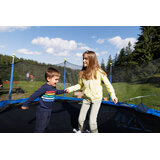Types of Trampolines: Your Comprehensive Guide to Making an Informed Choice
Author: Jump Star Trampolines Date Posted:26 December 2023

As a popular feature in many Australian backyards, trampolines offer countless hours of fun and exercise for the whole family. Before selecting your perfect trampoline, it's essential to understand the different types available, as each comes with its own unique set of features and advantages. In this comprehensive guide, we will explore the various trampoline options at Jump Star Trampolines, discussing the pros and cons of each, so you can make an informed decision based on your family's requirements.
Whether you're prioritising size, safety, budget, or even added accessories, learning about the diverse trampoline options available on the market will enable you to find the best fit for your backyard. So, let's dive into the world of trampolines and determine which is the perfect choice for your family's jumping adventures.
1. Round Trampolines
Pros: Round trampolines are the most traditional and common type found in home settings. They offer a centralised bounce that naturally directs jumpers towards the middle, which can be helpful for children and beginners who are learning to jump with control. Round trampolines are also more budget-friendly than some other shapes, making them an accessible option for many households.
Cons: Due to the centralised bounce effect, round trampolines may have a reduced overall bounce area compared to other designs. Additionally, round trampolines may not withstand high-intensity use as effectively as other shapes, such as rectangular trampolines.
2. Rectangular Trampolines
Pros: Rectangular trampolines often feature a higher bounce, owing to their even distribution of springs across the frame. This bounce style can be ideal for experienced jumpers, athletes, or gymnasts who require more space to perform advanced tricks and flips. The rectangular shape also makes it easier to fit in narrow or long backyards, which can be a deciding factor for some families.
Cons: Generally, rectangular trampolines are more expensive compared to round trampolines due to their larger size and additional features. The increased bounce area and intensity may also pose an increased risk of injury for inexperienced jumpers if proper safety measures aren't followed.
3. Springless Trampolines
Pros: Springless trampolines, or soft-edge trampolines, eliminate the use of traditional metal springs and instead rely on flexible rods or elastic bands for their bounce. This design significantly reduces the risk of injury associated with uncovered metal springs. Springless trampolines offer a safer alternative without compromising the overall jumping experience.
Cons: The absence of metal springs makes springless trampolines more expensive than traditional models. Additionally, while springless trampolines provide ample bounce, the experience may differ from that of spring-based models, which some jumpers may need time to adapt to.
4. Mini-Trampolines or Rebounders
Pros: Mini trampolines or rebounders are compact-sized trampolines designed for individual users, primarily adults focusing on fitness and exercise. Rebounders provide a low-impact cardiovascular workout that can help strengthen muscles and improve balance, among other health benefits.
Cons: Due to their small size, mini trampolines are not suitable for recreational jumping or for multiple users simultaneously. Their size and bounce limit the ability to perform advanced tricks or flips.
5. In-ground Trampolines
Pros: In-ground trampolines are installed level with the ground, creating a less obtrusive and visually appealing backyard addition. Falling from an in-ground trampoline poses a lower risk of injury than from an above-ground model due to the reduced height. In-ground trampolines offer a sleek and integrated backyard jumping experience.
Cons: Installing an in-ground trampoline requires significant excavation work, which can result in higher initial costs and effort. Additionally, in-ground trampolines may have reduced airflow compared to above-ground models, somewhat affecting the bounce height.
6. Water Trampolines
Pros: Water trampolines bring the excitement of trampolining to a pool or lake setting, providing a unique and refreshing experience. Many water trampolines include additional features such as water slides, climbing walls or inflatable canopies, providing more fun for the whole family.
Cons: Water trampolines are generally more expensive than traditional backyard trampolines, and their usage is limited by access to suitable water locations. They also require additional preparation and storage considerations compared to standard trampolines.
7. Fitness Trampolines
Pros: Fitness trampolines resemble mini-trampolines but typically feature additional accessories, such as handlebars, resistance bands, or non-slip surfaces. These trampolines are designed for home workout routines, providing low-impact cardiovascular exercise and functional training.
Cons: Similar to mini-trampolines, fitness trampolines are not meant for recreational use or multiple jumpers. Additionally, their primary focus on fitness makes them unsuitable for performing tricks and acrobatics.
8. Bungee Trampolines
Pros: Bungee trampolines offer an adrenaline-pumping jumping experience, utilising a harness system and bungee cords to propel jumpers to extreme heights. Bungee trampolines are popular at amusement parks, fairs, and adventure centres, providing a thrilling and memorable experience for participants.
Cons: Bungee trampolines are not suitable for home use due to their complex setup, higher cost, and heightened safety requirements. They cater primarily to adventure and thrill-seekers in controlled environments rather than for daily backyard jumping.
Discover the Ideal Trampoline Type for Your Family
Having explored the various trampoline options available, from traditional round and rectangular designs to innovative springless and in-ground models, you're now well-equipped to make an informed decision while selecting the perfect trampoline for your home. Each trampoline type offers its own unique benefits tailored towards specific activities, design preferences, and safety considerations.
Ready to find your family's ideal trampoline? Browse the extensive collection of the best trampolines in Australia at Jump Star Trampolines and choose the perfect option based on your requirements and preferences. Let us help you create the ultimate backyard jumping experience for the whole family, ensuring endless fun, entertainment, and an investment in quality and safety.






